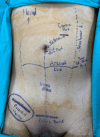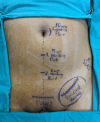A retrospective comparative study of the enhanced view-totally extraperitoneal technique versus the traditional totally extraperitoneal technique in managing recurrent inguinal hernias
- PMID: 40783522
- PMCID: PMC12335110
- DOI: 10.1186/s12893-025-03105-2
A retrospective comparative study of the enhanced view-totally extraperitoneal technique versus the traditional totally extraperitoneal technique in managing recurrent inguinal hernias
Abstract
Background: International guidelines recommend a laparoscopic approach in patients with recurrent inguinal hernia after open anterior repair. It is unclear which laparoscopic approach should be used. The aim of the study was to evaluate the safety and efficacy of the laparoscopic enhanced view-total extraperitoneal (eTEP) technique and total extraperitoneal (TEP) technique in the treatment of recurrent inguinal hernias.
Methods: The retrospective cohort study compared patients with unilateral recurrent inguinal hernia after anterior repair who underwent eTEP or TEP technique from February 2023 to February 2024. The two groups were compared in demographic characteristics and surgical and postsurgical data. The primary outcome of this study was recurrence and operation time.
Results: A total of 62 patients were analyzed. The eTEP technique was performed on 32 patients, while the TEP technique was used on 30 patients. The mean follow-up period was 18.3 (± 5) months. There was no recurrence in either group. The mean operative time was 44.4 (± 10.4) minutes for the eTEP group and 45.7 (± 10.2) minutes for the TEP group (p = 0.62). Pneumoperitoneum occurred in 14 (43.7%) patients in the eTEP group and 20 (66.7%) patients in the TEP group (p = 0.07). The mean time to return to activities was 6.8 (± 2.7) days for the eTEP group and 6.9 (± 2.3) days for the TEP group (p = 0.57). Chronic pain was reported in only 1 (3.3%) patient in the TEP group (p = 0.48). The length of stay in the hospital was 1 day for both groups. Hematoma formation was observed in 3 (9.3%) patients in the eTEP group and 3 (10%) patients in the TEP group; seroma formation was reported in 2 (6.2%) and 2 (6.7%) patients, respectively (p = 0.99).
Conclusion: The eTEP technique demonstrated results similar to TEP, particularly regarding recurrence, operation time, and postoperative outcomes. Like TEP, eTEP is a safe and viable option for recurrent inguinal hernias. Furthermore, prospective randomized studies comparing these two techniques are necessary for recurrent inguinal hernias.
Keywords: Recurrent; Recurrent inguinal hernia repair; eTEP.
© 2025. The Author(s).
Conflict of interest statement
Declarations. Consent for publication: Not applicable. Competing interests: The authors would like to affirm that they have no conflicts of interest to disclose. Ethics approval: All procedures conducted in studies involving human participants adhered to the ethical standards set forth by the institutional research committee, as well as the 1964 Helsinki Declaration and its subsequent amendments or other comparable ethical guidelines. The University of Health Sciences at Van Training and Research Hospital’s ethics committee granted approval for the study on November 29, 2024. Consent to participate: Written informed consent was obtained from all participants involved in this study, ensuring that the ethical standards of research were upheld.
Figures




Similar articles
-
Transabdominal pre-peritoneal (TAPP) versus totally extraperitoneal (TEP) laparoscopic techniques for inguinal hernia repair.Cochrane Database Syst Rev. 2024 Jul 4;7(7):CD004703. doi: 10.1002/14651858.CD004703.pub3. Cochrane Database Syst Rev. 2024. PMID: 38963034 Free PMC article.
-
Comparison of Early Results of Laparoscopic Transabdominal Preperitoneal and Total Extraperitoneal Repair in Recurrent Inguinal Hernia.J Laparoendosc Adv Surg Tech A. 2025 Aug;35(8):659-663. doi: 10.1089/lap.2025.0067. Epub 2025 Jun 11. J Laparoendosc Adv Surg Tech A. 2025. PMID: 40495725
-
Laparoscopic surgery for inguinal hernia repair: systematic review of effectiveness and economic evaluation.Health Technol Assess. 2005 Apr;9(14):1-203, iii-iv. doi: 10.3310/hta9140. Health Technol Assess. 2005. PMID: 15842951
-
Comparison of open and laparoscopic inguinal hernia repair in the elderly patients: a randomized controlled trial.Hernia. 2025 May 23;29(1):179. doi: 10.1007/s10029-025-03368-x. Hernia. 2025. PMID: 40407912 Free PMC article. Clinical Trial.
-
Mesh versus non-mesh for inguinal and femoral hernia repair.Cochrane Database Syst Rev. 2018 Sep 13;9(9):CD011517. doi: 10.1002/14651858.CD011517.pub2. Cochrane Database Syst Rev. 2018. PMID: 30209805 Free PMC article.
References
-
- Kingsnorth A, LeBlanc K. Hernias: inguinal and incisional. Lancet. 2003;362:1561–71. 10.1016/S0140-6736(03)14746-0. - PubMed
-
- Burcharth J, Andresen K, Pommergaard H-C, Bisgaard T, Rosenberg J. Recurrence patterns of direct and indirect inguinal hernias in a nationwide population in Denmark. Surgery. 2014;155(1):173–7. 10.1016/j.surg.2013.06.006. - PubMed
-
- Pisanu A, Podda M, Saba A, et al. Meta-analysis and review of prospective randomized trials comparing laparoscopic and Lichtenstein techniques in recurrent inguinal hernia repair. Hernia. 2015;19:355–66. 10.1007/s10029-014-1281-1. - PubMed
Publication types
MeSH terms
LinkOut - more resources
Full Text Sources

